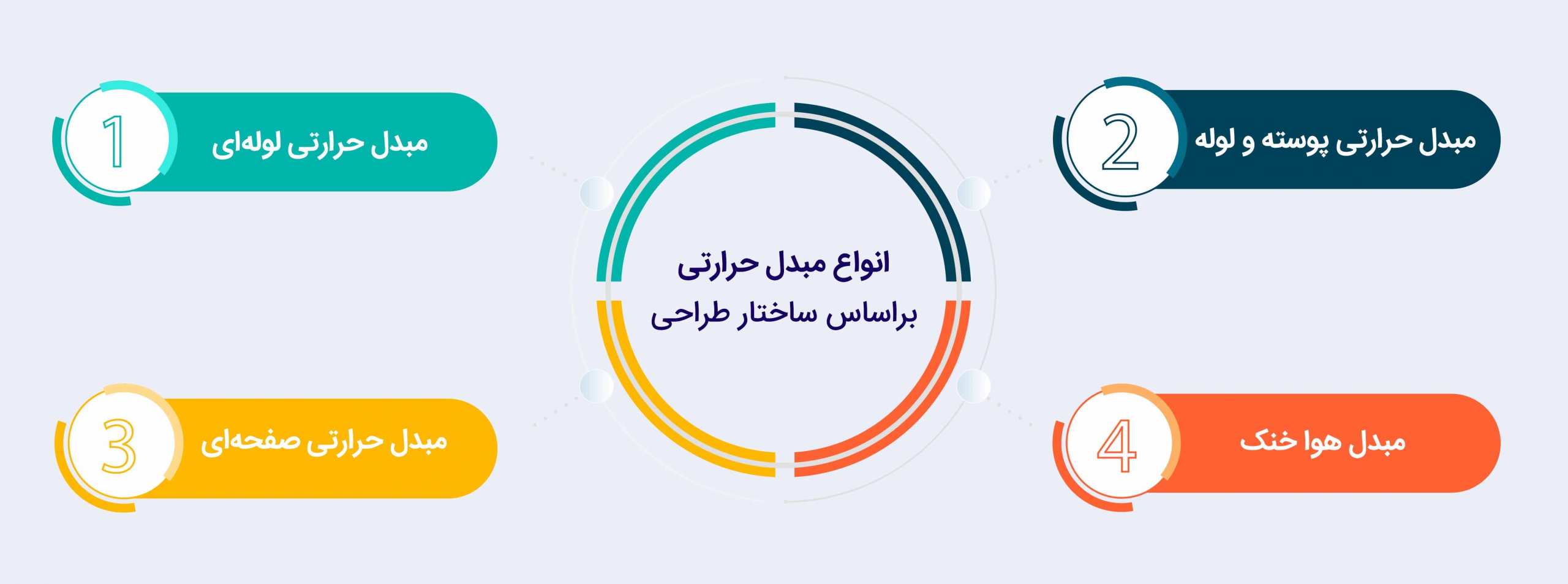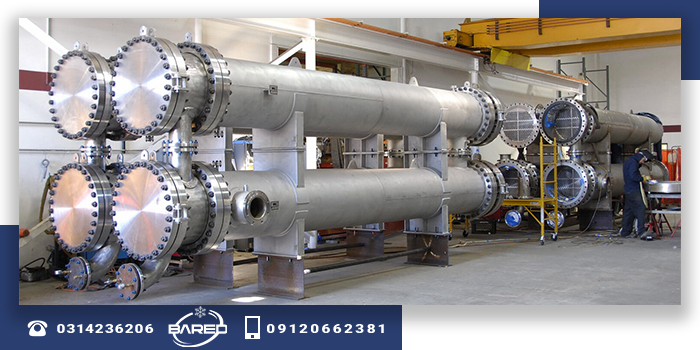Types of heat exchangers
انواع مبدلهای حرارتی
Before dealing with the types of heat exchanger, it is necessary to have an explanation about the heat exchanger. In the HVAC industry, one of the most important components in all systems is the heat exchanger. A heat exchanger is a device in which two or more fluids transfer heat together. The purpose of this heat transfer is to cool or heat a fluid or an environment. Usually, the design of this equipment is such that the fluids flowing in it do not mix together.
Heat exchangers are usually classified based on factors such as design structure, fluid flow arrangement, refrigerant type and working pressure, contact surface, etc., which is the most common classification based on design structure. In this article, the types of heat exchangers are reviewed based on the design structure and fluid flow arrangement.
انواع مبدل حرارتی براساس آرایش جریان
parallel flow heat exchanger
In these converters, the direction of cold and hot flow are parallel and in line with each other, in such a way that the cold and hot flow enters from one side of the converter and leaves from the other side. At the beginning of the path, two fluids have the largest temperature difference with each other, and at the end, the difference reaches the lowest level. Heat transfer has a direct relationship with the temperature difference, and the greater the temperature difference between two fluids, the more heat transfer takes place. As a result, in the parallel flow at the inlet of the converter, there is the highest heat transfer and it gradually decreases. In parallel flow converters, at no point in the path does the temperature of the cooling fluid heat up more than the temperature of the fluid.
Countercurrent Flow Heat Exchangers
In these converters, the flow direction of two fluids is parallel to each other but opposite to each other. In this way, the cold fluid (coolant) enters from one side of the converter and the hot fluid enters from the other side, and along the way, these two flows are parallel to each other.
In these exchangers, the temperature difference of the two fluids is almost equal at every section, so the amount of heat transfer is the same and uniform at all sections.
Heat exchangers with perpendicular flow (Cross Flow)
In these converters, the directions of cold and hot flows are perpendicular to each other. One of the most well-known converters with this design is car radiator and heating radiator. In these converters, which are also known as cross-flow converters, there are two concepts called mixed flow and non-mixed flow. Mixing and non-mixing depends on the velocity components. If the fluid flow has components in two directions, this flow is called mixed, and the fluid that flows only in one direction is called non-mixed flow. In heat exchangers with perpendicular flow, the flow inside the coils is unmixed. If the coils have fins, the fluid flow outside is also unmixed, otherwise it is considered mixed flow.
انواع مبدل حرارتی براساس ساختار طراحی
In this part, 4 common models of heat exchangers are reviewed based on the design structure.
Tubular Heat Exchanger (Tubular Pipe)
In tubular heat exchangers, there are two tubes of different sizes, one with a smaller diameter and the other with a larger diameter. The smaller tube is placed inside the larger tube and concentric with it. The way these converters work is that one of the fluids flows inside the smaller tube and the other flows in the middle space of the two tubes, and the two fluids exchange heat with each other. In these converters, which are also known as double pipe converters, the inner tube wall forms the heat transfer surface, which is usually finned to increase the surface area of the inner tube.
Design of tubular heat exchanger
In these converters, the two-fluid flow can be parallel (Parallel Flow) or opposite (Counter Flow). Of course, the highest efficiency is related to the opposite flow. In the opposite flow, two fluid inlets are placed in two different directions.
Application of tubular heat exchangers
Tubular exchangers have a simple design and low manufacturing cost and are used for heat transfer in high-pressure fluids. But compared to other competitors, they do not have high heat transfer capacity and efficiency. However, in order to achieve more heat transfer capacity, several of these converters can be placed in a row together, of course, in a vertical direction. The way of heat transfer in this model is that it either changes the temperature of a small volume of fluid by a large amount or changes the temperature of a large volume of fluid by a small amount. Tubular heat exchangers are usually used in the food and air conditioning industries.
Shell and tube heat exchangers
One of the most common types of heat exchangers is the Shell and Tube exchanger. In this converter, which is made of a large cylindrical shell and a number of tubes that are placed inside the shell. One of the fluids enters these tubes and the other fluid enters the converter shell. In this way, the heat transfer process is carried out from the surface of the pipes.
The fluids used in this converter can be both liquid and gas. If only liquid fluid or gaseous fluid is flowing inside the converter, this model is called single phase. In other cases, the converter is two-phase, for example, the fluid inside the coil enters as a liquid and evaporates and turns into a gas with heat transfer. Usually, the coils are made of copper, but in some cases, depending on the type of use, aluminum, steel, brass, etc. can be used.
Shell and tube heat exchanger design
The internal structure and the way of connections and arrangement of coils inside shell and tube converters are very diverse. In these converters, tubes are used either straight or bent in a U shape. In U-shaped coils, this method reduces the resistance of the pipes in the bent area due to bending, and there is a possibility of failure. For this reason, this model is usually used in low capacities. In shell and tube exchangers, there are other components such as tube sheet, baffle, plenum, which are discussed in the article on shell and tube heat exchanger. In these converters, like the tubular converter, the opposite flow has the highest efficiency.
Application of shell and tube heat exchangers
One of the important applications of Shell and Tube converters is the evaporator of air-cooled chillers and the evaporator and condenser of water-cooled chillers. Shell and tube heat exchanger is one of the best choices in applications that are supposed to be performed on a large volume of heat transfer fluid. For this reason, one of the most used converters in industries such as petrochemicals, steel, papermaking, drug production, power plants, etc. is these converters.
Plate heat exchanger
In plate converters, instead of using several tubes, there are a number of plates that are placed in a row and with a small distance from each other. The design and construction of plate heat exchangers is such that two fluids pass through the plates and do not mix. In simpler words, two fluids are flowing between the plates as one in between. The pages are also sealed in the middle.
The surface of these plates are smooth or wavy, and they are usually made of stainless steel to resist corrosion and withstand high temperatures. As the fluid moves between the plates, they have more surface area for heat transfer, resulting in more heat transfer. For this reason, to create a certain amount of heat transfer, plate exchangers have a smaller size than other exchangers.
Since the distance between both plates is small, the fluid will have a turbulent and eddy flow. This feature increases the heat transfer coefficient of the flow and increases the efficiency of the device. On the other hand, due to the large shear stress in the corners of the plates, the amount of sediment in these converters is much less. These positive features of the screen converter have made screen converters widely used in various industries today. Of course, this model can withstand lower pressures than shell and tube exchangers.
Plate converters are divided into 3 categories based on their structure, which are:
A) Gasket Plate Heat Exchanger
In these converters, plastic gaskets are placed between the plates so that it sticks around the edge of the plate and there is no possibility of leakage and mixing of fluids. In these gasketed exchangers, if we intend to change the heat transfer capacity, the number of metal plates can be increased or decreased. This model of converters is suitable for fluids with large volume and low or medium pressure.
b) Brazed plate heat exchangers
In this type, the corrugated plates are connected to each other with the help of a filler material and a soldering process. Brazed plate heat exchanger is used for heat transfer in high pressure fluids.
c) Welded plate heat exchangers
In this model, different plates are placed next to each other and welded together. The cooling and heating capacity of these converters is fixed and it is no longer possible to add or subtract plates. The welded plate heat exchanger has the ability to transfer heat at high temperature and pressure, and thus it is widely used in large industries.
Air cooled or fan converters
In these exchangers, where heat exchange takes place between air and another fluid, there are a number of coils and one or more fans. Hotter fluid flows inside the coils and air is circulated around the coils by a fan. In order to increase the contact surface of the air with the coils and thus increase the amount of heat transfer, the coils are usually equipped with fins. Air particles hit the heated surface of the coil and vane, take the heat from the fluid and cause the fluid to cool. Air-cooled exchangers are divided into three categories: vertical, horizontal and V-shaped.
Application of various types of heat exchangers
As mentioned at the beginning of the text, a heat exchanger is a device for exchanging heat between two or more fluids with different temperatures. This heat exchange is sometimes for heating and sometimes for cooling; Sometimes it is for industrial use and sometimes for air conditioning.
Among the industrial applications of heat exchangers, we can mention food industries, chemical industries, manufacturing industries, power plants, oil and gas refineries, pharmaceuticals, paper industries, etc.










Leave a Reply
Want to join the discussion?Feel free to contribute!